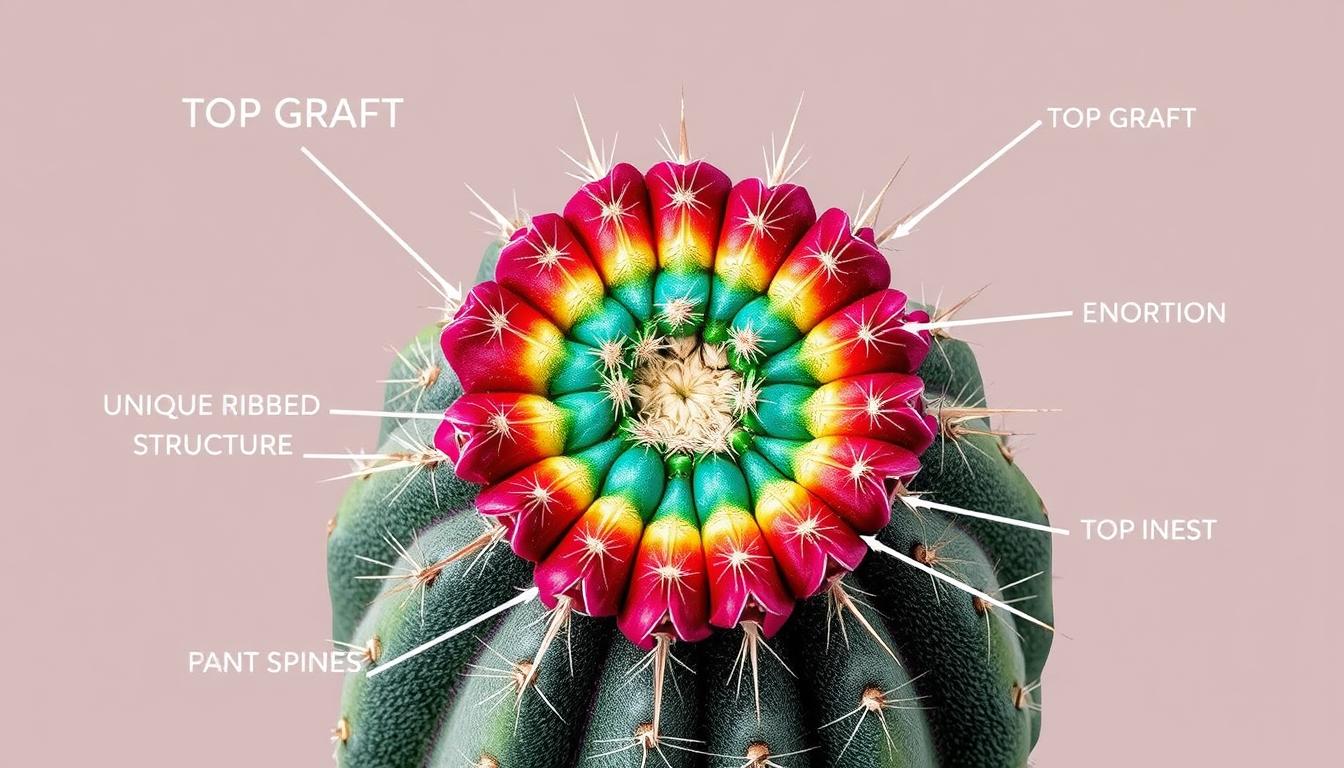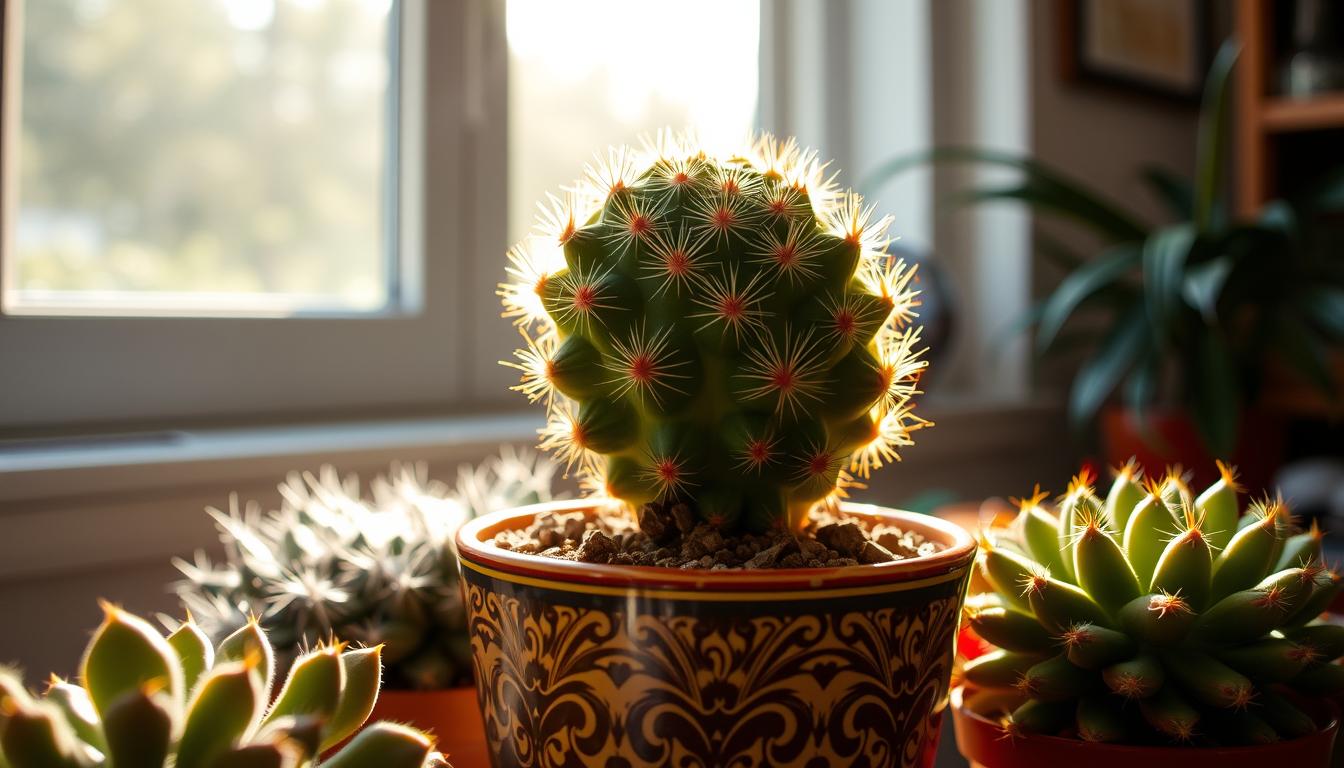The moon cactus, with its bright neon colors and unique structure, is a true marvel among indoor plants.
I’ve always been drawn to the moon cactus’s stunning beauty.
Its bright, neon colors and unique shape make it a favorite among indoor gardeners.
Hailing from South America’s lush lands, the moon cactus, or Gymnocalycium mihanovichii, is a true wonder of the plant world.
The moon cactus stands out because it’s a grafted plant.
It has a colorful top part (scion) joined to a green base cactus, often a Hylocereus species.
This setup lets the colors shine while the base plant feeds and supports it.
This guide is for both experienced and new plant lovers, sharing the best ways to grow and care for your moon cactus.

Key Takeaways
- Moon Cactus is a grafted succulent with a colorful top and a green base
- Native to South America, it’s a popular houseplant known for its neon-like appearance
- Requires bright, indirect light and minimal watering for optimal growth
- Can be propagated by division, but grafting is the preferred method
- Sensitive to wet soil and performs best in a dry, warm environment
Introduction to Moon Cactus: A Unique Grafted Beauty
The moon cactus is a stunning member of the cactus family.
It’s a grafted plant that mixes the bright colors of a Gymnocalycium mihanovichii with the green base of a Hylocereus cactus.
This blend makes a beautiful plant that many people love.
What Makes Moon Cactus Special
The moon cactus stands out because of a natural change.
This change stops it from making chlorophyll, the green stuff most cacti have.
So, it shows off bright colors like orange, red, yellow, and pink.
Native Origins and Development
The moon cactus comes from South America, especially Paraguay and Argentina.
It’s a small, slow-growing plant that can grow up to 12 inches tall.
Normally, it’s green, but the color change stops it from making chlorophyll, which it needs to live.
To survive, it’s grafted onto a green cactus base, like a Hylocereus species.
This base gives it the nutrients and support it needs.
Basic Characteristics
The moon cactus is a mix of two cactus types, with the colorful top being a Gymnocalycium mihanovichii.
These grafted cacti grow fast and can get about 3 inches tall and wide.
They like partial shade and well-draining soil, and need little water to avoid root rot.
“The moon cactus is a true testament to the ingenuity and adaptability of nature, captivating us with its vibrant hues and unique grafting process.”
Understanding the Moon Cactus Structure
The moon cactus is a unique and captivating plant.
It has two distinct parts: the colorful scion (top) and the green rootstock (bottom).
The scion, a mutated Gymnocalycium mihanovichii, is the vibrant and eye-catching part.
The rootstock, often a Hylocereus species, is the green base.
This grafted structure allows the top to survive by getting nutrients from the green base.
The graft union between the two parts is crucial for the plant’s survival.
But it can also be a point of vulnerability.
Moon cacti typically live for one to three years if well cared for.
This is shorter than other cacti and succulents because of the grafting process.
To extend their lifespan, moon cacti may need to be re-grafted as the green base can grow faster than the colorful top.
| Part of the Moon Cactus | Description |
| Scion (Top) | The mutated Gymnocalycium mihanovichii, responsible for the vibrant and eye-catching colors. |
| Rootstock (Bottom) | Often a Hylocereus species, providing the green base and essential nutrients for the scion’s survival. |

Understanding the moon cactus’s unique structure is key to its care and maintenance.
Recognizing the roles of the scion and rootstock helps gardeners meet the plant’s specific needs.
This ensures the moon cactus stays healthy and vibrant for a long time.
Light Requirements and Placement
Finding the right light balance is key for a moon cactus to grow well.
This unique grafted plant needs specific light conditions.
Indoor Light Conditions
Indoors, moon cacti do best in bright, indirect light. Place them near a window with plenty of filtered sunlight.
You can also use artificial LED lights, about 12-36 inches above, to match their light needs.
Outdoor Light Management
Outdoors, moon cacti need partial shade to keep their colors bright.
The variegated types are very sensitive to light.
They need careful placement to avoid sunburn.
Avoiding Sun Damage
It’s important to watch how much light they get.
Make changes slowly to see how they react.
If they start to stretch towards the light, they need more sun.
The right amount of light is crucial for their health and growth.

“Moon Cacti thrive under bright, indirect light during spring, indicating a preference for this light condition during the growth spurt period.”
Watering Guidelines for Optimal Growth
Caring for a moon cactus is all about finding the right balance with water.
These unique plants are naturally good at handling dry conditions and need water only when the soil is very dry.
Water them deeply every 2-3 weeks when it’s warm, and even less often when it’s cold.
Too much water can cause root rot, so it’s crucial to keep the soil dry.
For the best results, use soil that drains well and pots with holes in the bottom.
When you do water, make sure to water at the base of the plant.
This helps avoid fungal problems.
Moon cacti love dry air and should only get water when the soil is dry to the touch.

Remember, the key to healthy moon cactus is to water deeply but infrequently, allowing the soil to dry out before the next watering.
| Watering Frequency | Soil Moisture | Temperature Range |
| Every 2-3 weeks (growing season)1-2 times per month (winter) | Completely dry | 22-24°C (active growth)16-18°C (winter)Minimum 7-8°C |
By following these watering tips, your moon cactus will stay healthy and colorful.
Soil Requirements and Potting Mix
For a moon cactus to thrive, the right soil mix is key. It needs well-draining, sandy soil that keeps moisture and air.
The soil’s pH should be acidic to neutral, between 5.5 and 7.0.
Best Soil Components
Don’t rely on “cactus” soils from stores.
They mix sand and peat, not ideal for most cacti.
Make a custom mix with one part potting soil, two parts pumice, and one part coir.
Coir, from coconut husks, holds moisture and improves soil structure.
For epiphytic cacti, add coarse orchid bark to the mix.
It helps retain water for the roots.
Drainage Essentials
Good drainage stops water from staying in the soil and prevents root rot.
Add gravel or small rocks at the pot’s bottom for drainage.
Cacti like being close together, needing only an inch (2.5 cm.) of space.
Repot your moon cactus every 3-4 years to refresh the soil and encourage growth.
The best time is during the warm growing season.

By following these tips, you can create the perfect environment for your moon cactus.
This ensures its health and beauty for years.
“The cactus soil mix discussed in the article serves as an example of creating a custom mix and may need adjustments based on specific cacti species, environmental conditions, and availability of materials.”
Temperature and Humidity Needs
Moon cacti love warm temperatures between 70°F to 100°F (21°C to 38°C).
But, they don’t do well in cold, especially below 50°F (10°C).
This can make their colors fade, grow slowly, and wilt.
To keep them happy, avoid cold drafts and provide shade when it’s sunny.
This prevents sunburn and dehydration.
Moon cacti also need dry air, with humidity between 10-30%. Too much moisture can make them soft and sickly.
Too little can make them thirsty.
To keep the right humidity, use humidifiers, group plants, or put them in a steamy bathroom.
For less moisture, increase air flow, move them to drier places, or use a dehumidifier.
By watching temperature and humidity, you can help your moon cacti grow well and show off their colors.
Smart thermostats can also help keep the right temperature, making a cozy home for these plants.
| Temperature | Ideal Range | Potential Issues |
| Warm | 70°F to 100°F (21°C to 38°C) | Optimal for growth and blooming |
| Cold | Below 50°F (10°C) | Color fading, slow growth, wilting |
| Extreme Heat | N/A | Sunburn-like discoloration, dehydration, tissue damage |
Keeping a steady temperature and watching humidity helps your moon cacti thrive.
“Careful temperature and humidity control are essential for the health and beauty of moon cacti.”
Fertilizing Your Moon Cactus
To keep your moon cactus healthy, you need to fertilize it right.
It needs nitrogen, phosphorus, and potassium to stay colorful and strong.
Use a fertilizer with a balanced NPK ratio, like 1-1-1 or 2-1-1, and make sure it has more potassium for cacti.
Feed your moon cactus every month from April to September.
When to Feed
It’s important to know when to fertilize your moon cactus.
Feed it monthly with cactus fertilizer from April to September.
Don’t fertilize in winter because the plant is sleeping, and it can get too much food.
Types of Fertilizer
Cacti like the moon cactus need regular food to grow well.
They need nutrients like nitrogen, phosphorus, and potassium for growth.
Use a fertilizer with less nitrogen to keep the plant’s colors bright and not too leafy.
The soil should be slightly acidic to neutral, so pick a fertilizer with a pH of 6 to 7.
Good brands for moon cactus fertilizer include Espoma Cactus Plant Food, Miracle-Gro Succulent Plant Food, and Hoffman Organic Cactus and Succulent Soil Mix.
Too much fertilizer can harm your plant, causing leaf burn, wilting, and stunted growth.
To avoid this, follow the instructions, flush the soil when needed, and only fertilize during growing seasons.
Also, dilute liquid fertilizers as directed.
Propagation and Grafting Techniques
Propagating moon cacti is special because the colorful top needs a host to survive.
To start, carefully remove the top part and attach it to a new root.
Use a sharp, clean knife to make precise cuts and join the vascular tissues.
Secure them with rubber bands until they grow together.
This method takes patience but can keep your moon cactus alive forever.
Offset propagation is quick, as it uses small versions of the original plant.
Seed propagation, on the other hand, can lead to new plants that might look different from the parent.
But, Moon Cacti rarely flower at home, making seed propagation rare. Seeds can take weeks to months to germinate, showing the need for patience.
Keeping things clean and sterilized is key to successful moon cactus propagation.
They need bright, indirect light and a warm spot to grow well.
The soil should drain well to avoid root rot, with about 80% inorganic materials like perlite.
Watching for new growth and root development is important.
Look out for signs of disease, pests, or weak roots. Using clean tools, proper soil, and light is crucial for success.
When transplanting, choose the right pot and soil, and focus on light, temperature, and watering.
Propagating moon cactus is a way to grow your indoor garden and beautify your space.
Moon cacti usually live for six months to a year without chlorophyll.
But, with the right techniques, you can enjoy their beauty for years.
| Propagation Method | Advantages | Challenges |
| Offsets | Fast establishment of new cactiIdentical to parent plant | Limited number of offsetsPotential for disease transmission |
| Seed Propagation | Potential for new, unique plantsExpanded plant collection | Rare flowering eventsLengthy germination process |
| Grafting | Extends the life of moon cactiAllows for colorful top to thrive | Requires precision and practicePotential for graft rejection |
In summary, grafting is the best way to propagate moon cacti.
It lets the colorful top live on a healthy root.
While other methods have benefits, grafting is key for growing moon cactus successfully.
Common Problems and Troubleshooting
The moon cactus is a unique and striking plant, but it faces some common challenges.
Overwatering is a big issue, leading to root rot.
To avoid this, water your moon cactus every two weeks. Make sure the soil is completely dry before watering again.
Sunburn can also cause beige spots on the vibrant colors.
Disease Prevention
Proper watering and lighting are key to preventing diseases.
Avoid overwatering to prevent root rot. Use well-draining soil and let it dry out completely between waterings.
Bright shade and 1-2 hours of slanted sunlight daily can also help prevent issues.
Pest Control
Moon cactuses can get pests like mealybugs and spider mites, especially when new.
Use neem oil or insecticidal soap to treat these pests. Keeping your plant healthy is the best way to fight pests.
Growth Issues
Moon cactuses don’t grow much, even with good care.
After a few years, the graft may separate, needing to be regrafted.
Too much direct sunlight can also cause colors to fade.
By understanding these common problems and following best practices, your moon cactus can thrive.
It will keep its vibrant, otherworldly appearance.
| Issue | Symptoms | Solution |
| Overwatering | Root rot, soft base | Allow soil to dry completely between waterings |
| Sunburn | Beige spots on color | Provide bright shade with limited direct sun |
| Pests | Mealybugs, spider mites | Treat with neem oil or insecticidal soap |
| Graft Separation | Loosening of scion from rootstock | Regraft scion to new rootstock |
Seasonal Care and Maintenance
Caring for your moon cactus means adjusting your routine with the seasons.
In spring and summer, water it more often and watch for new growth.
In fall and winter, water less, letting the soil dry out completely.
Also, keep it away from cold drafts and move it to a cooler spot, around 50-60°F.
Only fertilize your moon cactus when it’s actively growing.
Check the plant for pests or diseases, especially when the seasons change.
Catching problems early keeps your moon cactus healthy and bright.
Adapting to Seasonal Changes
- Increase watering frequency in spring and summer to support growth
- Reduce watering in fall and winter, allowing soil to dry completely
- Protect from cold drafts and consider moving to a cooler spot (50-60°F) in winter
- Fertilize only during the growing season, avoiding dormant periods
- Regularly inspect for pests and diseases, especially during seasonal transitions
| Season | Watering | Sunlight | Fertilizer |
| Spring/Summer | Increase frequency | Bright, indirect | Apply during growth |
| Fall/Winter | Reduce, allow soil to dry | Bright, indirect | Avoid dormant period |
Adjusting your care to the seasons helps your moon cactus thrive.
Keep an eye out for problems and fix them fast.
This ensures your moon cactus stays healthy and colorful for a long time.
Knowing what your moon cactus needs is crucial for great care.
Follow these seasonal tips to help your moon cactus grow and enjoy its beauty for years.
Decorative Uses and Companion Planting
Moon cacti are perfect for adding a splash of color to your space.
They look great with other small cacti and succulents in dish gardens or terrariums.
They can also be used as colorful accents on desks, windowsills, or in hanging planters.
When you mix moon cacti with other plants, make sure they all need similar care.
This way, you’ll have a beautiful and healthy display.
The moon cactus is great for small spaces and indoor gardens.
Its bright colors can make any room look better and improve your mood.
It’s also a great way to learn about plants and how they work together, interesting for gardeners and science fans.
Adding moon cacti to your indoor plants or succulent displays is a great idea.
They bring color and interest to your space. Whether alone or with other plants, they are sure to grab everyone’s attention.
FAQ
What makes moon cacti unique?
Moon cacti are special because they combine two cacti. The colorful top is a mutated Gymnocalycium mihanovichii. It’s grafted onto a green Hylocereus base. This mix creates vibrant colors due to a lack of chlorophyll.
Where do moon cacti originate from?
Moon cacti come from South America, mainly Paraguay and Argentina. They grow up to 12 inches tall and are quite compact.
How do moon cacti survive without chlorophyll?
The colorful top of the moon cactus can’t make chlorophyll. But, it’s grafted onto a green base that can photosynthesize. This setup lets the top part get nutrients from the green base.
What type of lighting do moon cacti need?
Moon cacti need bright, indirect light. The colorful top can’t handle direct sunlight. The green base, however, needs more light for photosynthesis. Place them near a window with filtered light or a few hours of gentle morning sun.
How often should moon cacti be watered?
Moon cacti like infrequent, deep watering. Water them when the soil is dry, about every 2-3 weeks in the growing season. Water less in winter. Avoid too much water to prevent root rot.
What type of soil do moon cacti prefer?
They do well in sandy, well-draining soil. Use a cactus mix or make your own with potting soil, sand, and perlite. Good drainage is key to prevent water retention and root rot.
What temperature and humidity conditions are best for moon cacti?
They like warm temperatures, 70-80°F (21-27°C). They can handle cooler temperatures but avoid frost. In winter, keep them between 50-60°F (10-15°C). They prefer low to moderate humidity, making them great for indoor spaces.
How should moon cacti be fertilized?
Fertilize them lightly during the growing season (spring to early fall). Use a balanced fertilizer diluted to half strength or a cactus fertilizer. Apply once a month. Don’t fertilize in winter when they’re dormant.
How can moon cacti be propagated?
Propagation involves grafting, as the colorful top can’t survive alone. Remove the colorful scion and graft it onto a new rootstock. This method requires patience but can keep your moon cactus alive forever.
What are common issues with moon cacti?
Issues include overwatering, sunburn, and graft separation. Pests like mealybugs and spider mites can also be a problem. Too much direct sunlight can cause color fading. Proper care can prevent most of these issues.
Source Links
- https://greg.app/plant-care/moon-cactus
- https://cafeplanta.com/a/blog/exploring-the-enigmatic-moon-cactus-in-the-wild
- https://greg.app/moon-cactus-light-requirements/
- https://www.thespruce.com/grow-grafted-ruby-ball-cactus-1902604
- https://careforplant.com/moon-cactus-guide-to-grow-and-care
- https://cactiguide.com/article/?article=article8.php
- https://greg.app/moon-cactus-temperature/








3 Responses